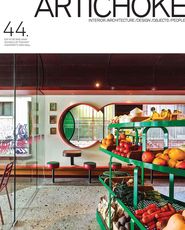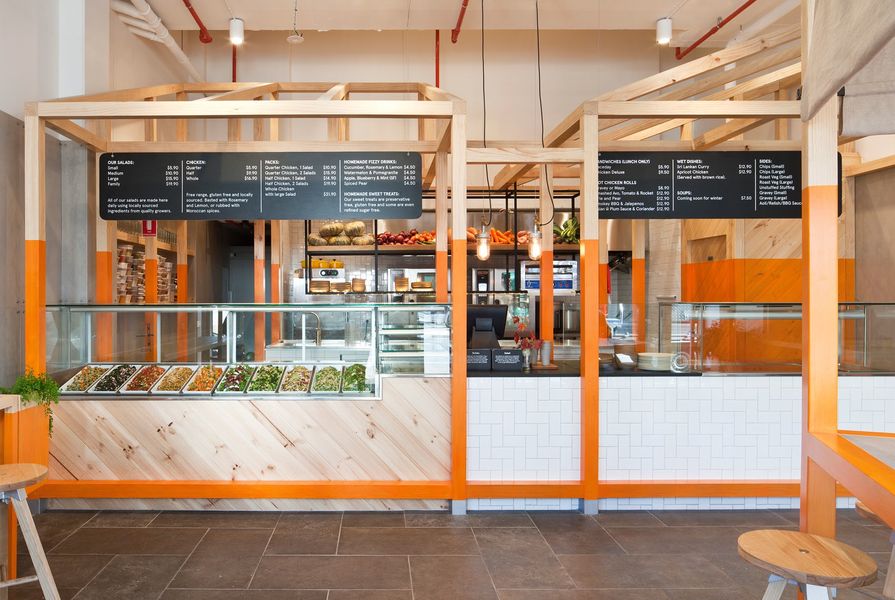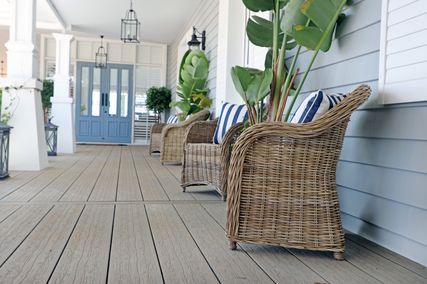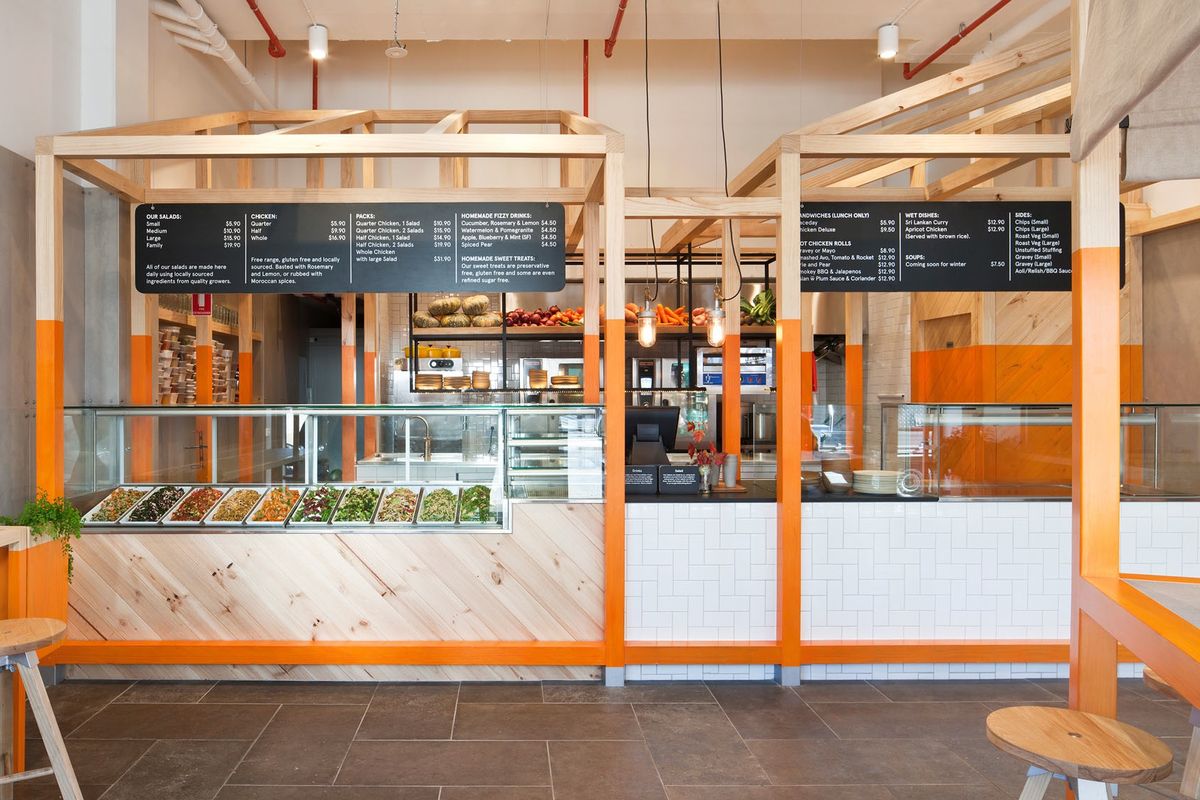No-one could accuse Foxes Den of being unethical – not only does its chicken shops serve free-range chicken and salads made from locally sourced, seasonal produce, but this Melbourne-based brand has taken up another cause, what it considers the unfair vilification of our vulpine friend, the fox. In its new retail space in Port Melbourne, designed by Hecker Guthrie, Foxes Den wanted to show the world that these animals are more than just chicken-coop-raiding predators; they are urbane creatures whose sophisticated palates and busy lifestyles demand the balanced nourishment that forms the core of their menu. These modern epicureans require a space befitting their refined tastes and Hecker Guthrie was charged with designing a contemporary shop and dining area where foxes, and no doubt humans, would feel comfortable.
The story of Foxes Den’s adopted mascot provided the starting point for the project. Hecker Guthrie has created a sort of urban farm, where light, airy dimensions and a modern colour palette connect the space to its inner-city, beachside location, while robust materiality evokes a rural experience. The design team effectively brought pieces of the farm into the space, making what director Hamish Guthrie calls “structures within structures.” Bare wooden A-frames demarcate the counter and preparation area, mimicking the exposed beams and pitched roof of a barn. In the eating area, a calico-covered wooden hutch creates a place for congregation and dining, in keeping with the rustic aesthetic.
These elements were constructed on-site and Hecker Guthrie worked closely with the builder, who fully embraced the challenges of the detailed work. Guthrie says that the opportunity to work hands-on and create bespoke elements is one of the things he has most enjoyed about working on Foxes Den and other small-scale projects undertaken recently by the practice. The raw materiality of the space also allowed Hecker Guthrie to work within the budget – unlined ceilings and simple, painted, wooden wall coverings fit in well with the overall look and feel. Three-legged wooden stools by Henry Wilson and exposed light bulbs perfectly complement the bare-bones aesthetic.
Light, airy dimensions and a modern colour palette connect the space to its inner-city, beachside location.
Image: Shannon McGrath
Hecker Guthrie was trusted with a brief containing only the simple mandate to create a dynamic and energetic space. Neutral grey tones allow the brightly coloured salads and food displays to take centre stage, while orange lends a distinctive vibrancy to the eating areas. The small site made circulation important, especially given the requirement to house the commercial kitchen that produces food for both the Port Melbourne site and the other Foxes Den location in Elwood.
The space evokes a rural aesthetic by featuring “structures within structures.”
Image: Shannon McGrath
Several devices are used to disperse customers around the dining areas, from a water bar on one side to side-bar eating on the other, as well as the central dining hutch. Although no firm plans have been made for further expansion of the brand, Hecker Guthrie wanted to establish a strong design language that could be rolled out at other locations if necessary. Understanding that part of the Foxes Den ethos is a connection to place, the designers focused on creating individual elements that could be reinterpreted and reassembled to reflect the identities of different areas, while continuing the Foxes Den brand narrative.
Guthrie acknowledges that the constraints of small projects can often produce truly original responses, the compressed time frames giving designers no room to second-guess or over-think decisions. His measure of success for projects like Foxes Den is a design process where both the client and the architects learnt something and had a lot of fun along the way. Like the fox, we’re happy to eat the results of their hard work.
Products and materials
- Walls and ceilings
- Tiles in ‘Miltenberg’ from Metz Tiles. Lea Ceramche Slimtech tiles in ‘Stuccata’ from Skheme. Walls painted in ‘Natural White’ from Dulux. Hard plaster finish in ‘Marmorino White’ from Bishop Decor.
- Joinery
- Limewashed radiata pine members supplied by builder, partly painted in Wattyl Interior Design Luxury Low Sheen in ‘Mandarin Grove.’
- Windows and doors
- Canvas tarps supplied by builder. Wired glass by Viridian.
- Flooring
- Seville tile from Eco Outdoor.
- Lighting
- Davey Lighting Well Glass pendant light from Dunlin Homes. Mantra mount linear light from M Light. Reggiani lights, Squad strip lighting and track light from Euroluce. Deeper Down downlights from Darkon Architectural Lighting. Angled Tom mounted wall light from Volker Haug.
- Furniture
- A3 self-assemble high stool by Henry Wilson. BacSac decorative planter sacks from Kif + Katast.
- Bathroom
- Cosmic Compact vanity basin from Rogerseller. Mizu basin mixer from Reece. Icon sink mixer and toilet roll holder from Astra Walker. Starck toilet suite from Duravit.
Credits
- Project
- Foxes Den
- Architect
- Hecker Guthrie
Melbourne, Vic, Australia
- Project Team
- Paul Hecker, Hamish Guthrie
- Consultants
-
Builder
Westbank Constructions
Project manager Hayden Dyt
- Site Details
-
Location
99 Bay Street,
Port Melbourne,
Melbourne,
Vic,
Australia
Site type Suburban
- Project Details
-
Status
Built
Design, documentation 8 months
Construction 3 months
Category Hospitality, Interiors
Type Restaurants, Retail
Source

Project
Published online: 12 Dec 2013
Words:
Jill Pope
Images:
Shannon McGrath
Issue
Artichoke, September 2013
























